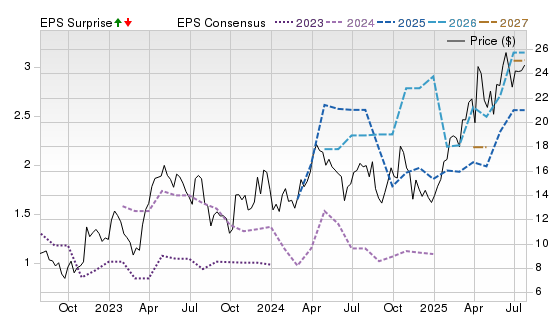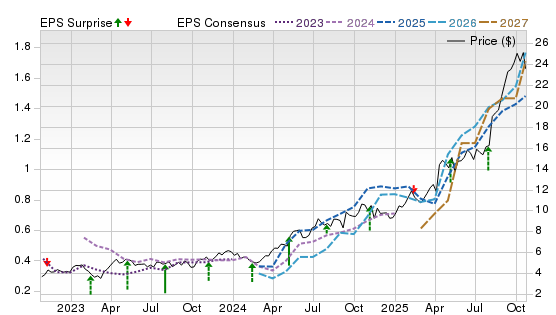5 Best Gold Stocks to Buy Today
| Company (Ticker) | 12 Week Price Change | Forward PE | Price | Proj EPS Growth (1 Year) | Projected Sales Growth (1Y) |
|---|---|---|---|---|---|
| Gold Fields Limited (GFI) | 24.57% | 12.72 | $38.41 | 131.06% | 53.71% |
| Kinross Gold (KGC) | 27.01% | 15.20 | $23.24 | 130.63% | 26.87% |
| AngloGold Ashanti PLC (AU) | 18.88% | 11.90 | $68.00 | 162.44% | 60.96% |
| Newmont (NEM) | 19.17% | 14.04 | $80.97 | 68.47% | 12.63% |
| Triple Flag Precious Metals Corp. (TFPM) | 6.27% | 30.35 | $27.76 | 72.59% | 28.55% |
*Updated on October 31, 2025.
Gold Fields Limited (GFI)
$38.41 USD -0.37 (-0.95%)
3-Year Stock Price Performance

Premium Research for GFI
- Zacks Rank
 Strong Buy 1
Strong Buy 1
- Style Scores
C Value A Growth A Momentum A VGM
- Market Cap: $34.71B (Large Cap)
- Projected EPS Growth:131.06%
- Last Quarter EPS Growth:NA
- Last EPS Surprise:NA
- Next EPS Report date:NA
Our Take:
Gold Fields is a global gold producer with large, long-life mines in Australia, Ghana, South Africa, and Peru, plus the new Salares Norte mine in Chile, an asset that expands leverage to bullion in the Americas. The Chile ramp-up has been bumpy due to harsh winter conditions, but management has added heat tracing and plant encapsulation and frames the asset as a multi-year volume and margin driver.
A Zacks Rank #1 (Strong Buy) reflects positive estimate revisions. Style Scores of C for Value and A for both Growth and Momentum suggest that investors are rewarding improving operations and rising earnings visibility, despite a fully valued backdrop.
On GFI’s Price, Consensus & EPS Surprise chart, shares sit near highs while 2026–2027 EPS estimates trend higher after a mid-2025 step-up, indicating analysts are building in a steadier Salares Norte ramp and healthier group production.
Kinross Gold (KGC)
$23.24 USD -0.60 (-2.52%)
3-Year Stock Price Performance

Premium Research for KGC
- Zacks Rank
 Strong Buy 1
Strong Buy 1
- Style Scores
B Value A Growth F Momentum B VGM
- Market Cap:$28.85B (Large Cap)
- Projected EPS Growth: 130.88%
- Last Quarter EPS Growth: 46.67%
- Last EPS Surprise: 33.33%
- Next EPS Report date:Nov. 4, 2025
Our Take:
Kinross is a senior gold producer anchored by the Tasiast mine in Mauritania, the Paracatu mine in Brazil, and a pipeline led by the Great Bear project in Red Lake, Ontario, which is framed as a long-life, high-margin development in a top jurisdiction. Financially, Kinross has leaned into free-cash-flow generation, reducing debt and reinforcing liquidity while reaffirming a steady multi-year production profile, supporting that can fund Great Bear and shareholder returns through cycles.
Its Zacks Rank #1 reflects upward estimate momentum. A Style Score B for Value and A for Growth indicates improving profitability at a reasonable multiple, while Momentum at F simply flags recent trading chop rather than fundamentals.
KGC’s chart shows a persistent uptrend since 2024, with 2025–2027 EPS estimates rising in tandem, an encouraging confirmation that the market is rewarding improving operations and the emerging contribution from Great Bear.
AngloGold Ashanti PLC (AU)
$68.00 USD -1.00 (-1.45%)
3-Year Stock Price Performance

Premium Research for AU
- Zacks Rank
 Strong Buy 1
Strong Buy 1
- Style Scores
C Value B Growth B Momentum A VGM
- Market Cap:$28.96B (Large Cap)
- Projected EPS Growth:162.44%
- Last Quarter EPS Growth: 42.05%
- Last EPS Surprise:-4.58%
- Next EPS Report date:Nov. 11, 2025
Our Take:
AngloGold Ashanti is a diversified gold miner with a growing U.S. footprint through its Beatty District projects in Nevada, including Silicon and Merlin, large oxide systems advancing toward development. Beatty’s scale is a key medium-term growth driver, with ongoing drilling and engineering targeting a multi-deposit mining complex. The first production in the district is slated from adjacent assets before ramping to a sizable platform later in the decade.
Its Zacks Rank #1 reflects favorable estimate revisions. Style Scores of C for Value and B for both Growth and Momentum reflect a balanced profile, not the cheapest, but with clear growth visibility and improving sentiment.
AU’s chart highlights a sharp breakout accompanied by materially higher 2026–2027 EPS estimates, reflecting anticipated contributions from the Beatty complex and improving operating trends across the base.
Newmont (NEM)
$80.97 USD -1.34 (-1.63%)
3-Year Stock Price Performance

Premium Research for NEM
- Zacks Rank
 Strong Buy 1
Strong Buy 1
- Style Scores
B Value C Growth A Momentum B VGM
- Market Cap: $89.82B (Large Cap)
- Projected EPS Growth: 68.39%
- Last Quarter EPS Growth: 19.58%
- Last EPS Surprise:32.56%
- Next EPS Report date: Feb. 19, 2026
Our Take:
Newmont is the world’s largest gold miner following its acquisition of Newcrest, which also increased copper exposure and deepened its Tier-1 asset base across Australia and the Americas. Post-deal, management has prioritized portfolio high-grading and balance-sheet repair, outlining asset sales and synergy targets to focus capital on the most profitable mines while deleveraging. The breadth of long-life, low-cost assets provides significant torque to sustained gold strength.
Its Zacks Rank #1 highlights fresh estimate upgrades. A Style Score of B for Value, C for Growth, and A for Momentum suggests improving earnings trajectories with strong technical follow-through, even if growth is more incremental than step-function.
NEM’s chart shows a sharp recovery with 2026–2027 consensus lines turning up, consistent with expectations for project start-ups and portfolio rationalization to drive steadier free-cash-flow through the cycle.
Triple Flag Precious Metals Corp. (TFPM)
$27.76 USD -0.53 (-1.87%)
3-Year Stock Price Performance

Premium Research for TFPM
- Zacks Rank
 Strong Buy 1
Strong Buy 1
- Style Scores
F Value C Growth C Momentum D VGM
- Market Cap: $5.84B (Mid Cap)
- Projected EPS Growth:72.22%
- Last Quarter EPS Growth:20.00%
- Last EPS Surprise:14.29%
- Next EPS Report date:Nov. 4, 2025
Our Take:
Triple Flag is a precious-metals royalty and streaming company with a diversified, gold-weighted portfolio that offers exposure to rising bullion without operating cost inflation. The platform achieved record performance as key assets such as Northparkes and Cerro Lindo contributed, while the company continued to expand its development pipeline. Production commenced at Johnson Camp Mine and Tres Quebradas in Q3 2025, generating initial revenue and further broadening Triple Flag’s portfolio of cash-flowing operations.
Its Zacks Rank #1 reflects upward estimate revisions. While the Value Score is F, both Growth and Momentum at C highlight the appeal of long-life, low-risk cash flows as new assets contribute. The royalty model provides downside protection relative to miners while preserving torque to gold.
TFPM’s chart shows a steady advance with 2026–2027 EPS estimates stepping higher, consistent with portfolio expansion and compounding cash flows from new streams and royalties.
Methodology
The Zacks Rank is a proprietary stock-rating model that uses trends in earnings estimate revisions and earnings-per-share (EPS) surprises to classify stocks into five groups: #1 (Strong Buy), #2 (Buy), #3 (Hold), #4 (Sell) and #5 (Strong Sell). The Zacks Rank is calculated through four primary factors related to earnings estimates: analysts' consensus on earnings estimate revisions, the magnitude of revision change, the upside potential and estimate surprise (or the degree in which earnings per share deviated from the previous quarter).
Zacks builds the data from 3,000 analysts at over 150 different brokerage firms. The average yearly gain for Zacks Rank #1 (Strong Buy) stocks is +23.62% per year from January, 1988, through June 2, 2025.
Selections for Best Gold Stocks are based on the current top ranking stocks based on Zacks Indicator Score. For this list, only companies that have average daily trading volumes of 100,000 shares or more and at least five analysts covering the stock were considered. All information is current as of market open, Oct. 31, 2025.
Guide to Gold Stocks
Is it a good time to invest in gold stocks right now?
Given that gold prices are already elevated and many forecasts point to further upside, now is considered a “reasonable time” by many analysts to consider gold stocks. The leverage effect of mining companies means they may outperform bullion if gold continues to rise.
However, one must also be cautious: valuations for some stocks might already reflect part of the rally, and risks remain (see next). It’s prudent to size positions carefully and maintain diversification.
Benefits of investing in gold stocks
- Operational leverage: As gold prices climb, miners’ margins expand because cost per ounce is relatively fixed.
- Dividend potential: Some mature gold companies pay dividends or buy back shares, offering a yield component beyond price appreciation.
- Portfolio diversification: Gold stocks can reduce correlation with typical growth stocks, providing a hedge in volatile markets.
Risks of investing in gold stocks
- Operational & geological risk: Mining has many moving parts—cost overruns, mine disruptions, regulatory issues, jurisdiction risks.
- Gold-price risk: If gold falls or stagnates (for example due to higher interest rates), miners will suffer in the opposite direction—sometimes more steeply.
- Valuation risk: Stocks may already price in strong future gold prices; if those don’t materialize, downside exists.
Gold stocks vs Gold stocks ETF vs physical Gold
- Physical Gold: You own actual bullion; no company risk, but you incur storage & insurance costs, no dividends, and liquidity might be lower.
- Gold stocks: You get corporate leverage to gold price, potential dividends, but you assume company-specific risks.
- Gold ETFs (physical bullion): Track gold price directly, low cost, easy to trade, no storage issues—but they don’t offer dividends or operations upside.
- Gold-mining ETFs: Bundle many gold stocks—diversifies company risk but still carries mining equity risk—and may amplify upside or downside relative to bullion.
How to Select the Best Gold Stocks
When evaluating individual gold names:
- Check cost per ounce (all-in sustaining cost) and production profile.
- Verify debt levels and balance-sheet health.
- Look for a diversified asset base (geography, mine life).
- Dividend or buyback policy.
- Management track-record and governance.
- Valuation relative to peers and forward earnings.
Gold stocks vs Silver stocks: Which one is better?
Silver stocks offer exposure to both precious-metal demand and industrial applications (solar panels, EVs, electronics), which creates a different demand profile. That said, silver often underperforms gold during safe-haven rushes and may carry extra cyclicality. For investors focused purely on a hedge or safe-haven, gold stocks are often the preferred choice—but mixing both may enhance diversification.
Market Trend and Forecast about Gold Stocks
What factors are driving gold prices?
Key drivers include:
- Central-bank buying of gold as part of reserves diversification.
- A weak U.S. dollar and lower real interest rates make gold more attractive (because gold yields no interest).
- Geopolitical uncertainty and inflation concerns push investors toward safe-haven assets.
- For miners: higher gold price, stable or declining costs per ounce, improved cash flows.
How do gold stocks perform during inflation or recession?
Historically, gold and gold-stocks have had better relative performance during periods of high inflation or economic stress—thanks to their hedge status. In recessions, while equities may falter, gold may hold its value or rise, which can support gold stocks. That said, mining companies may face production or cost pressures during downturns, so while the metal may hold up, company risks still exist.
Are gold mining stocks undervalued right now?
According to some research, yes. For example, one note points out that while gold has rallied significantly, many mining companies’ valuations remain conservative relative to the metal’s price — offering potential upside if the rally continues.
Still, because many investors have already rotated into the sector, valuations may be less of a bargain than in past cycles.
Will rising Interest rates hurt gold mining companies?
Rising real (inflation-adjusted) interest rates typically increase the opportunity cost of holding non-yielding assets like gold, which can weigh on gold prices—and thus miners. Additionally, higher rates increase costs for mining firms that borrow. On the flip side, if higher rates reflect inflation-risk or weakness in the economy, gold may benefit. So the net impact depends on the underlying cause of rate increases.
Gold ETFs and Alternatives
Are gold ETFs better than individual gold stocks?
If your primary goal is to track the price of gold (for example as a hedge) rather than pick specific companies, ETFs that hold physical gold may be a simpler, lower-risk approach. They eliminate much of the company-specific risk inherent in mining stocks. On the other hand, stock exposure offers the possibility of outsized returns (when gold rises) via operational leverage—but also greater downside.
Should I invest in gold mutual funds or ETFs? Where is the difference?
- Gold ETFs typically offer direct exposure, low expense ratios, high liquidity, and transparent holdings.
- Gold mutual funds may invest in a mix of gold stocks, sometimes along with other precious-metal companies, and may have higher fees or minimums. For many self-directed investors, ETFs are more efficient.
Which is appropriate depends on your tax situation, jurisdiction, and preferred investment vehicle.
Should I invest in gold for diversification or growth?
Gold is most commonly used as a diversifier—to reduce portfolio risk, hedge inflation, or provide safe-haven exposure. If you’re seeking growth, gold stocks (especially mining companies) may offer upside—but with higher risk. Understand the role you want gold to play in your portfolio before choosing.
How do dividends from gold companies compare to other sectors?
Many gold mining companies may pay dividends or buy back shares, but yields generally tend to be lower than high-dividend sectors such as utilities or REITs. Because their cash-flows are heavily dependent on commodity prices, dividends may be more variable and less predictable. Royalty/streaming companies often offer steadier payouts.
Best way to diversify with silver in a portfolio
Silver provides a related yet distinct exposure: it is both a precious metal and an industrial metal. To diversify with silver: consider silver-mining stocks or silver ETFs; assess how it correlates with gold and your broader portfolio; keep allocation moderate since silver can be more volatile. Pairing gold and silver may add another dimension of diversification.
Should I invest $1,000 Right now in Gold Stocks and What Will It Look Like?
If you invest $1,000 today in a basket of gold stocks or a gold-stock oriented ETF, here’s a simplified illustration:
- Suppose gold rises by 20% over the next year and miners, benefiting from operational leverage, rise by 30%.
- A $1,000 investment grows to $1,300 (assuming no fees/dividends).
- If instead gold stagnates or falls 10%, miners might fall 15-20% due to the leveraged effect, and you’d end up around $800-$850.
This underlines both the opportunity and risk. A prudent approach: allocate only a portion of your portfolio (e.g., 5-10%) to gold stocks, have a longer time horizon (3-5 years or more), and monitor costs, valuations, the macro backdrop, and company fundamentals.
Common Questions About Gold Stocks
Do gold stocks pay dividends?
Yes—many established gold companies (especially large-caps or royalty/streaming firms) distribute dividends or execute buy-backs. However, payout levels depend on production, gold price, costs, and company capital allocation decisions.
What stocks are backed by gold?
While no stock is “backed” by gold in the same way that a bullion bar is backed, many mining companies’ profitability is tied directly to the gold price. Royalty or streaming companies may also offer quasi-“gold exposure” via agreements to buy gold production at fixed prices.
Is Warren Buffett buying gold?
Historically, Buffett has expressed skepticism toward gold as a productive investment and has favoured businesses generating cash flow rather than commodities per se. There’s no major reported shift recently indicating he’s investing heavily in gold or gold stocks. (As always, check the latest filings for updates.)














